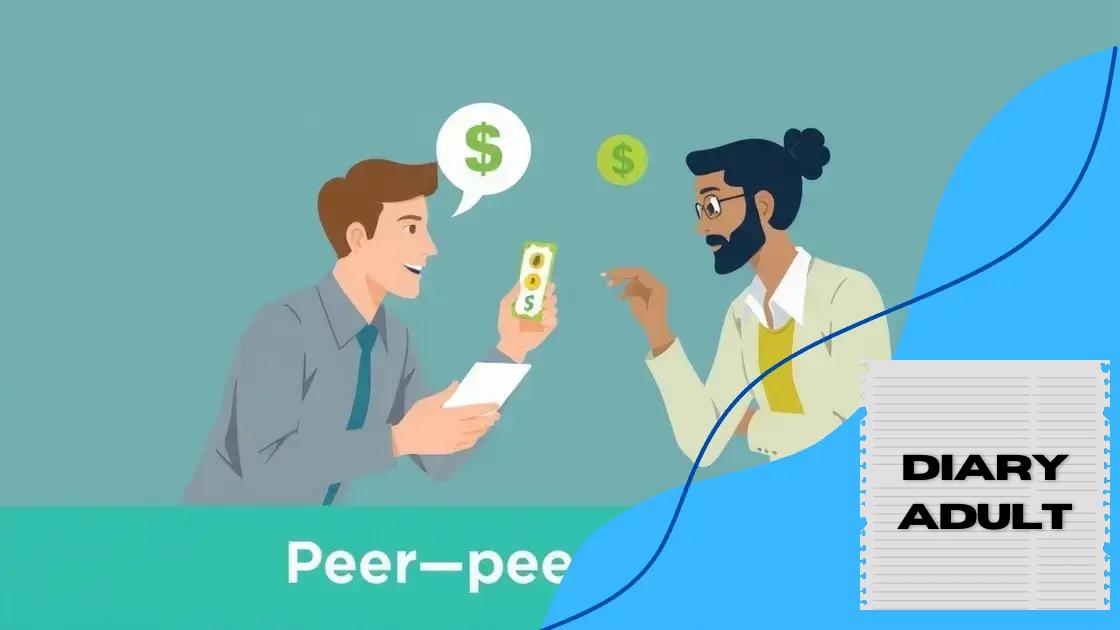The growth of peer-to-peer lending in 2025

The growth of peer-to-peer lending in 2025 enables borrowers to access funds faster and at lower interest rates while offering lenders attractive returns and investment opportunities, driven by technology and changing regulations.
The growth of peer-to-peer lending in 2025 is setting the stage for a financial revolution. Have you ever wondered how this model could reshape your borrowing options? Let’s dive into the details.
Understanding peer-to-peer lending
Understanding peer-to-peer lending is essential in today’s financial landscape. This innovative model connects borrowers directly with lenders, bypassing traditional banks. By doing so, it opens up new opportunities for everyone involved.
How Peer-to-Peer Lending Works
In a peer-to-peer platform, individuals can offer loans to others, and both parties benefit from favorable terms. Unlike banks, these platforms often have reduced fees and more flexible criteria. Borrowers usually start by applying online, providing relevant financial information.
Benefits for Lenders
Lenders often see attractive interest rates, which may be higher than those offered by traditional savings accounts. Here are some key advantages:
- Higher Returns: Lenders can earn significant interest on their investments.
- Diverse Portfolio: Investing in multiple loans spreads risk over various borrowers.
- Flexible Investment: Lenders choose the amount and terms that suit their preferences.
Peer-to-peer lending has gained popularity among those seeking alternatives to banks. It empowers individuals to take charge of their financial journeys while encouraging a community-based approach to lending. By addressing the needs of both borrowers and lenders, this method promotes a healthier financial ecosystem.
Additionally, many platforms provide tools and resources to help users make informed decisions. With the right information, both borrowers and lenders can engage in productive relationships, ensuring that lending becomes a win-win situation.
Key players in the market
In the peer-to-peer lending market, various key players shape the landscape. Understanding these players is crucial for anyone looking to engage in this type of lending. The market includes borrowers, lenders, and the platforms that facilitate these transactions.
Borrowers
Borrowers are individuals or small businesses seeking financial assistance. They benefit from lower interest rates and faster approval times compared to traditional banks. Often, borrowers turn to peer-to-peer lending out of necessity or a desire for more favorable terms.
Lenders
Lenders are typically individual investors who provide funds to borrowers. They are attracted by the potential for higher returns compared to traditional savings accounts. Here are some benefits of being a lender:
- Higher Interest Rates: Lenders can earn more on their investments.
- Diversification: By spreading investments across multiple loans, lenders can mitigate risk.
- Flexibility: Lenders choose loan amounts and terms that fit their financial goals.
Peer-to-peer lending platforms play a vital role in the process, connecting borrowers and lenders. These platforms have user-friendly interfaces, making it easy to navigate the borrowing and lending processes. Most platforms charge a fee, but this is often lower than the fees charged by banks.
Additionally, regulatory bodies monitor these platforms to ensure consumer protection. This oversight helps build trust among users. As a result, more people are embracing this model, which is changing the way we think about personal and business financing.
Benefits for borrowers and lenders

Peer-to-peer lending offers numerous benefits for both borrowers and lenders, making it an appealing alternative in today’s financial world. Understanding these advantages can help individuals make informed financial decisions.
Benefits for Borrowers
For borrowers, one of the main advantages is the potential for lower interest rates compared to traditional loans. Many borrowers turn to peer-to-peer lending because it offers quicker access to funds, which can be crucial during emergencies. Additionally, the application process tends to be more straightforward and accessible, allowing more people to qualify for loans.
Key Advantages:
- Lower Costs: Borrowers often enjoy reduced fees, making loans cheaper.
- Fast Approval: The streamlined process means borrowers receive funds quickly.
- Flexibility: Borrowers can choose loan amounts and repayment terms that suit their needs.
As borrowers find it easier to obtain loans, lenders also experience several advantages. Peer-to-peer lending platforms provide them with direct access to potential borrowers, creating opportunities for investment.
Benefits for Lenders
Lenders can earn higher interest rates compared to traditional savings accounts and investment options. This increased return on investment makes peer-to-peer lending an attractive choice. Moreover, lenders have the satisfaction of helping borrowers achieve their financial goals.
Investing through peer-to-peer lending also allows for diversification. Lenders can spread their money across many loans, reducing the risk associated with lending. This approach opens up possibilities for engaging in unique lending portfolios, benefiting both lenders and borrowers alike.
Regulatory landscape in 2025
The regulatory landscape for peer-to-peer lending is evolving rapidly as we move toward 2025. Governments and regulatory bodies recognize the need to create guidelines to protect consumers while fostering innovation in financial services. Understanding this landscape is crucial for both borrowers and lenders.
Key Regulations to Watch
As peer-to-peer lending grows, several regulations are taking shape. These regulations aim to balance the interests of investors and borrowers, ensuring fairness and transparency. Here are some significant changes expected:
- Transparency Requirements: Platforms may need to provide clearer information about fees and risks.
- Consumer Protection Laws: Enhanced rights for borrowers to prevent unfair practices.
- Investment Limits: Potential limits on how much individual lenders can invest to manage risk.
These changes aim to create a safer environment for users. Stricter oversight ensures that platforms remain accountable and that both parties understand their rights and responsibilities. In addition, some governments may introduce specific licenses for peer-to-peer platforms, making it essential for these companies to comply with new standards.
Global Trends
Regulations differ worldwide. Some countries may adopt stricter measures, while others may encourage innovation. This variation can create both opportunities and challenges for platforms operating across borders. Staying informed about these trends is vital for anyone engaged in peer-to-peer lending.
As we approach 2025, the regulatory landscape will keep evolving, adapting to the needs of the market and its participants. Continuous dialogue between policymakers, platforms, and users will help shape regulations that benefit everyone involved.
Future trends and predictions
The future trends in peer-to-peer lending are shaping the way finance works. As we look toward 2025, several key developments are on the horizon. These trends aim to enhance the user experience for both borrowers and lenders.
Increased Use of Technology
One significant trend is the increasing use of technology in lending platforms. AI and machine learning are starting to play vital roles in evaluating borrowers and assessing risks. This helps in making faster lending decisions while also personalizing offers for borrowers.
Growing Popularity of Ethical Investing
Ethical investing is becoming more popular among lenders. Many individuals are looking to invest their money in ways that align with their values. This shift means that peer-to-peer platforms may cater to lenders who want to support specific causes or projects.
Enhanced Regulatory Frameworks
As the market grows, we can expect enhanced regulatory frameworks to develop. Governments will likely introduce new rules to protect consumers while still encouraging innovation. These changes will help build trust in the system.
Global Expansion
Peer-to-peer lending is also likely to expand globally. More countries are recognizing the potential benefits of this lending model. As regulations become clearer, platforms may enter new markets, helping more people access financing.
Overall, the future of peer-to-peer lending looks promising. As technology advances and societal values shift, this model will adapt. By understanding these trends, borrowers and lenders can position themselves effectively for what lies ahead.
In conclusion, the growth of peer-to-peer lending by 2025 offers exciting opportunities for both borrowers and lenders. This modern financial approach enhances access to funds while providing attractive returns for investors. As technology advances and regulations evolve, it is essential for all involved to stay informed. Understanding the benefits, key players, and future trends will empower individuals to navigate the peer-to-peer lending landscape effectively. The potential for mutual growth and support in communities may lead to a transformative change in how we handle personal finance.
FAQ – Frequently Asked Questions about Peer-to-Peer Lending
What is peer-to-peer lending?
Peer-to-peer lending is a method that connects borrowers directly with lenders through online platforms, bypassing traditional banks.
How do I benefit as a borrower in peer-to-peer lending?
As a borrower, you can experience lower interest rates, faster access to funds, and a straightforward application process.
What advantages do lenders have in this model?
Lenders can enjoy higher returns on investments compared to traditional savings, along with the opportunity to support specific projects.
Are there any risks involved in peer-to-peer lending?
Yes, investing in peer-to-peer lending carries some risks, including borrower default, but diversification can help manage these risks.





